So, you finally decided to get a new tattoo and then went to a studio to get some new ink. But of course, you can’t help but wonder, how long does it take for a tattoo to heal?
View in gallery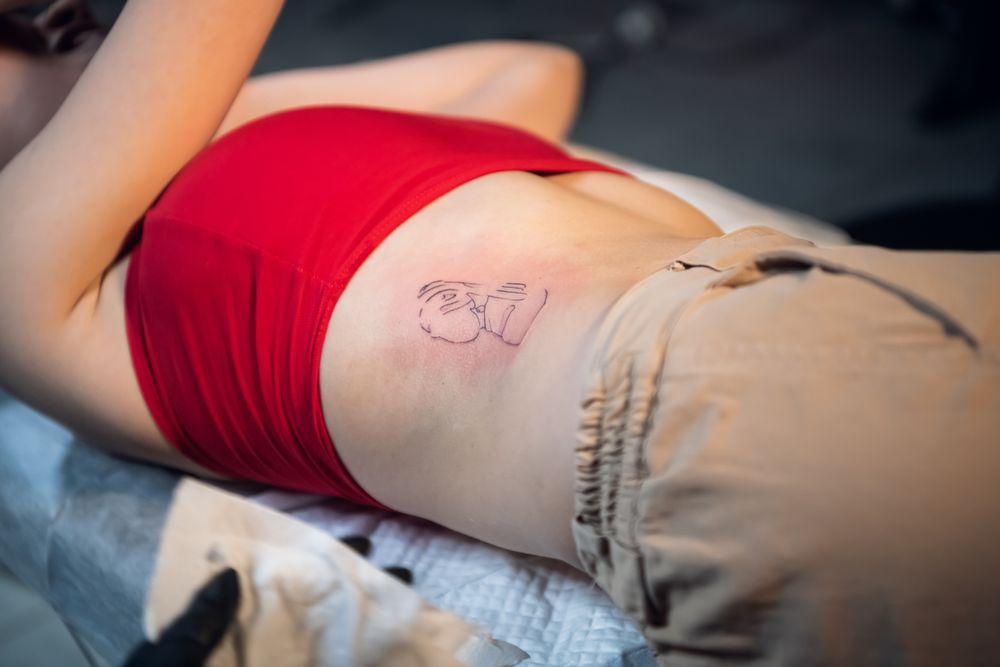
Two of the biggest decisions you need to make when getting inked are deciding on the tattoo design and finding the right, reputable tattoo artist to bring that art to life. But here’s the thing. The time you’re going to spend under the needle is a tiny part of the whole process.
Getting a tattoo doesn’t simply end the moment you go out of the tattoo studio with your fresh ink. Not just yet. There’s still one important part you and your new ink have to go through – the healing process.
But how long does the fresh tattoo healing process take? Is there something you can do to reduce tattoo healing time?
Read on as we’ve prepared a guide on what to expect regarding tattoo healing timelines, plus hacks to make your new tattoo heal faster so you can show it off and wear it with pride in no time!
How Long Does It Usually Take for a Tattoo to Heal?
Although they aren’t deep, tattoos are still considered open wounds. And like any open-skin wound, a tattoo will take time to heal. Most often, the process will take a couple of weeks. But other times, it can take over a month or even longer.
On average, a new, fresh tattoo will start looking healed at around 2-3 weeks. However, it can take up to an entire month for the skin to recover fully. During this time, it’s essential to continue with your tattoo aftercare.
View in gallery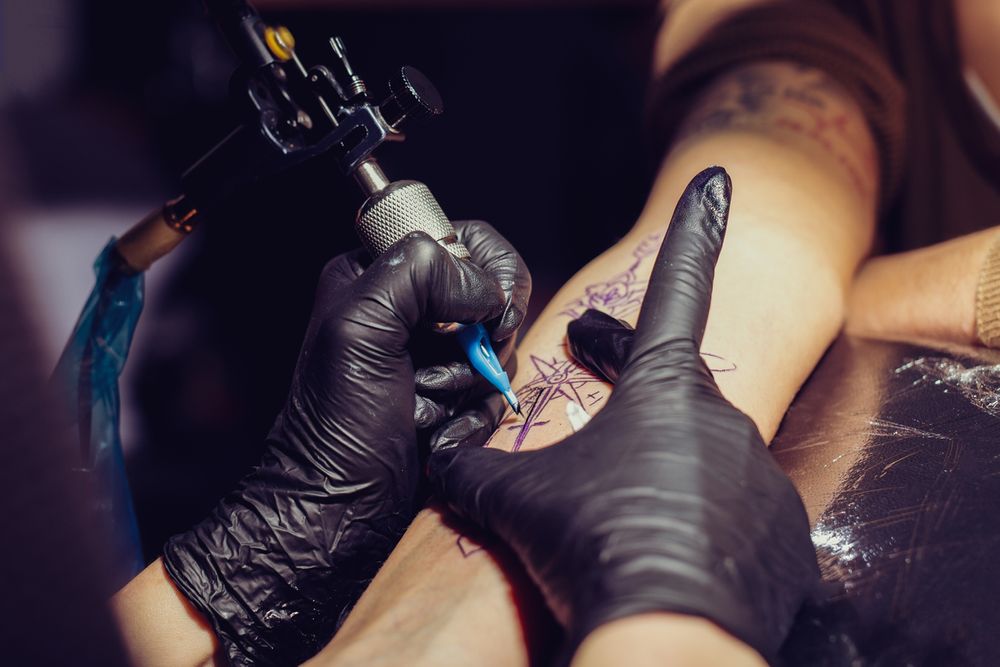
But while the outer part of the skin or the visible part of the tattoo may look and feel healed, the skin below it would require more recovery time.
Usually, it can take anywhere between 4-6 months for the deeper layers of the skin to truly heal and bounce back. This healing stage will result in the complete healing of all the layers on your tattooed skin.
That said, healing timelines for a tattooed area differ from person to person. A couple of different factors affect how fast or slow your new tattoo will heal.
It is why, although you might feel tempted to slack on your tattoo aftercare regimen, it’s important to take extra good care and precaution until your tattoo is healed fully.
Tattoo Healing Time: What to Expect?
While waiting for your tattoo to heal fully, here’s a basic view of the healing timeline, healing process, and what you can expect as your tattoo heals.
Generally, the tattoo healing process of your new can be divided into four stages:
Stage 1: Open Wound
This stage is the entire week following the day when you got inked. And during the first week, new tattoos are considered an open wound and will induce a typical bodily response to skin injuries.
What you can expect at this stage are some redness, oozing, and most likely slight inflammation in the tattoo area and surrounding skin.
In many cases, you can also feel a little burning sensation and see a bit of swelling in the area for a few days. Your tattoo will start scabbing by the latter end of the week, which is the skin’s way of closing an open wound.
Stage 2: Itching and Scabbing
By the second week after getting the tattoo, you can expect your skin to start itching and the tattoo flaking as the skin dries. Your epidermis is beginning to heal, and your white blood cells and plasma proteins have created a scabby cap over the once-open wounds.
The peeling skin, which can last for 7-10 days, indicates that the scabbed areas or your tattoo skin are beginning to heal.
Stage 3: Drying Out
During the third to fourth week, your tattoo will look fully healed, at least on the outside. However, the deeper layers of the skin are still on the mend at this stage.
In most cases, you won’t notice redness or any inflammation at this stage, although your tattoo might still appear a bit shiny and scaly for another few weeks.
View in gallery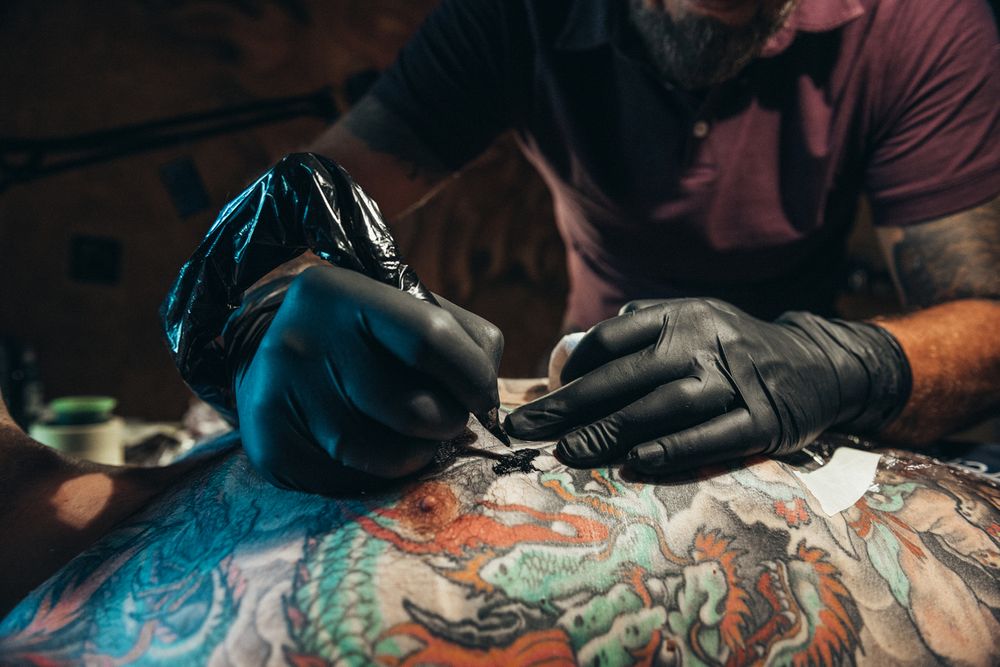
You might also notice a layer of dry skin covering your tattoo after the scabs have fallen off. It can sometimes make the ink appear duller. But don’t worry, as it’s only a new layer of epidermis that is yet to settle fully. Before long, that new layer of skin will eventually start looking like the rest of your skin, giving your new ink time to shine.
Stage 4: Completely Healed
At weeks 5-6, assuming that your tattoo is healing properly, meaning no open sores or infections, the outer layer of the skin should have healed entirely. Therefore, there shouldn’t be any burning sensation, swelling, or prolonged itching.
You’ll know that your tattoo is at this stage already once you notice that the scabs and dry skin have sloughed off, making way for smoother skin and a vibrant tattoo.
What Affects Tattoo Healing Time?
The overall healing process and the time it takes to complete the entire process differs from tattoo to tattoo and from person to person. While the tattoo healing stages above apply, the duration for each stage depends on a couple of factors:
- What style of tattoo did you get?
- Did you get a grey or colored tattoo?
- What is the size of your tattoo?
- What is the location or body placement of your new ink?
View in gallery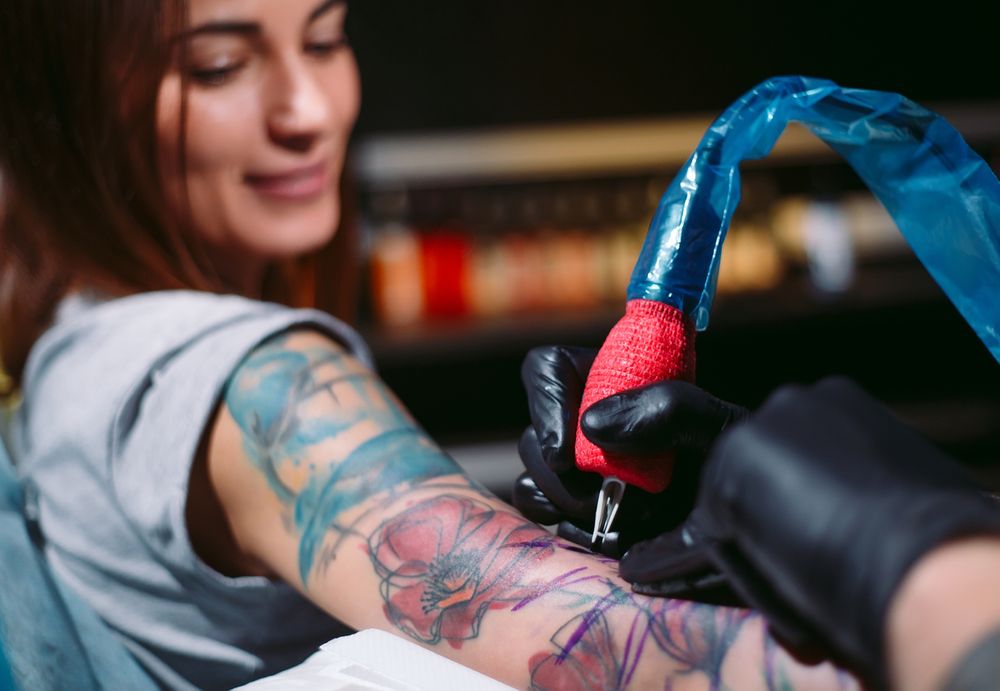
Black/Grey Tattoos vs. Colored Tattoos
Generally, a grey or black tattoo heals much faster than colored ones as it follows a less intense approach to tattooing.
Your tattoo artist will include some blank space or light shading for black and grey tattoos, causing little to no irritation or damage to the skin.
On the other hand, the execution tattoo artists have to do for a colored tattoo makes the healing period longer. When coloring a tattoo, the tattoo artist goes over every part of the body art and fills it with colored tattoo ink without any breaks.
In short, the process is intensive, irritating the skin more and causing more skin trauma.
Not to mention that colored tattoo inks also contain tiny amounts of metal, which the human body finds hard to accept. Ultimately, all that leads to a longer period of scabbing and healing.
View in gallery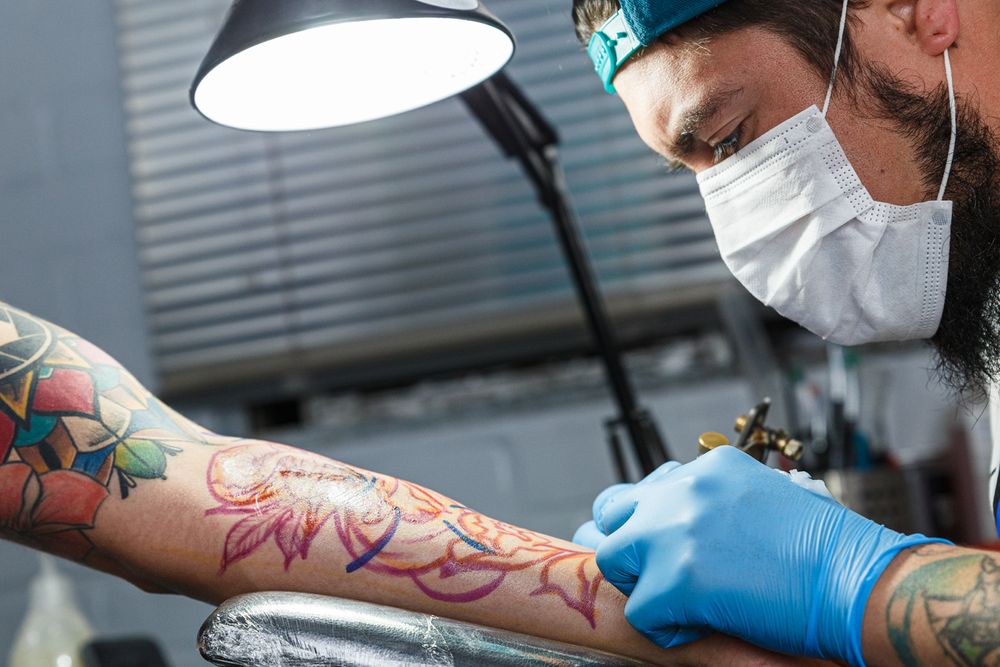
And out of all colors, red tattoo ink is a common culprit for causing adverse effects when it comes to healing duration due to its ink makeup. If you are one of the unlucky ones to have an adverse reaction to red ink, it can make your tattoos heal even longer. However, it can also make your new ink look a bit patchy once healed.
So while the outer layer of the skin for black and grey tattoos can heal after 2-3 weeks, the healing process and duration for colored tattoos can take 4-6 weeks if properly cared for.
Tattoo Location and Size
The time it usually takes for a tattoo to heal internally also depends on the tattoo’s location. Expect an extended healing process if you got fresh ink on a sensitive part of the body.
The most sensitive locations of your body to get a tattoo are those with very thin and tight skin, the least fat, and a lot of nerve endings. Such parts of the body include the ribs, fingers, spine, shins, and neck.
Besides being some of the most painful places to get a tattoo, they are also the most likely to experience longer prions of swelling, redness, and irritation.
In many cases, sensitive tattoos can take up to six or more weeks for the surface skin layer of the tattooed area to heal.
And understandably, larger tattoos will take a much longer healing process than smaller ones.
Tattoo Aftercare Choices
Getting a tattoo is just the beginning. Following proper aftercare for your new tattoo greatly affects how fast or slow the healing process will be and how it looks in the long term.
If you skimp on your tattoo care, you can delay the entire process. It’s why it’s essential to follow aftercare instructions throughout the entire healing stages. And that includes the following aftercare tips:
- Gently wash the tattooed area with antibacterial soap or gentle, fragrance-free soap before pat drying with a paper towel to keep the tattoo clean.
- Keep the tattooed skin moisturized with a fragrance-free lotion. Also, include the skin surrounding the tattoo to avoid itchiness. You can ask the tattoo artist or a supportive tattoo community for recommendations but try to avoid petroleum-based products.
- Try to lower sun exposure or use broad-spectrum sunscreen once the tattoo is healed for maximum sun protection.
- Wear loose clothes to avoid rubbing the healing skin.
Following such tips allow tattoos to heal properly and quickly.
View in gallery
General Health and Immune System
Based on your health, immune system, and age, your body will go through the entire healing process as fast as it can naturally.
For instance, it’s known that as you get older, the longer it takes for your body to heal, and that can affect how fast your skin recovers from the tattoo process. Moreover, any underlying health conditions can also extend the healing timeline.
How Do You Know a Tattoo Is Fully Healed?
There are loads of factors that can affect how well and how long your tattoo heals. So, how can you tell that a tattoo has healed completely?
-
No Cloudiness
When the scabs fall off the tattooed skin too soon, it will show you a cloudy skin surface, which is more visible in a darker-colored tattoo like blue and black. In addition, it will be noticeably paler than the skin surrounding it, which signifies that the deeper layer of skin is still healing.
Give it a week or two to continue healing. Once the cloudiness is gone, it’s a good sign that your tattoo is fully healed.
-
If Your Tattoo Doesn’t Hurt Anymore
Does your tattoo still hurt? That’s a good indication that it’s not completely healed yet. Pain is a signal of damage to your skin cells and nerves after the tattoo process.
Usually, a new tattoo will feel tender and sensitive for the first two weeks. That’s normal. But if the pain persists after a month of getting inked, then there’s a good chance that something more is going on.
-
Your Tattoo Has Stopped Peeling
If the tattooed area looks flawless with no signs of peeling, including thin dead skin cells that look like sunburn, then it’s most likely healed. Skin peeling or shedding is usually the last part of the damaged skin from the tattooing process.
-
You’ve Given It Enough Time to Heal.
Time is the simplest and often the best indicator that a tattoo has fully healed. If it’s 4-6 weeks after, and unless you have any medical condition that can slow healing or you experienced an allergic reaction from the tattoo, your tattoo should now fully heal.
Is Healing Taking Too Long? 8 Signs of Tattoo Infection
Skin redness, tenderness, and itchiness right after getting a tattoo are normal. After all, your skin is irritated after undergoing a lot of damage. However, if such symptoms don’t subside and your tattoo isn’t healing as it should after a couple of weeks, it might be an infection.
View in gallery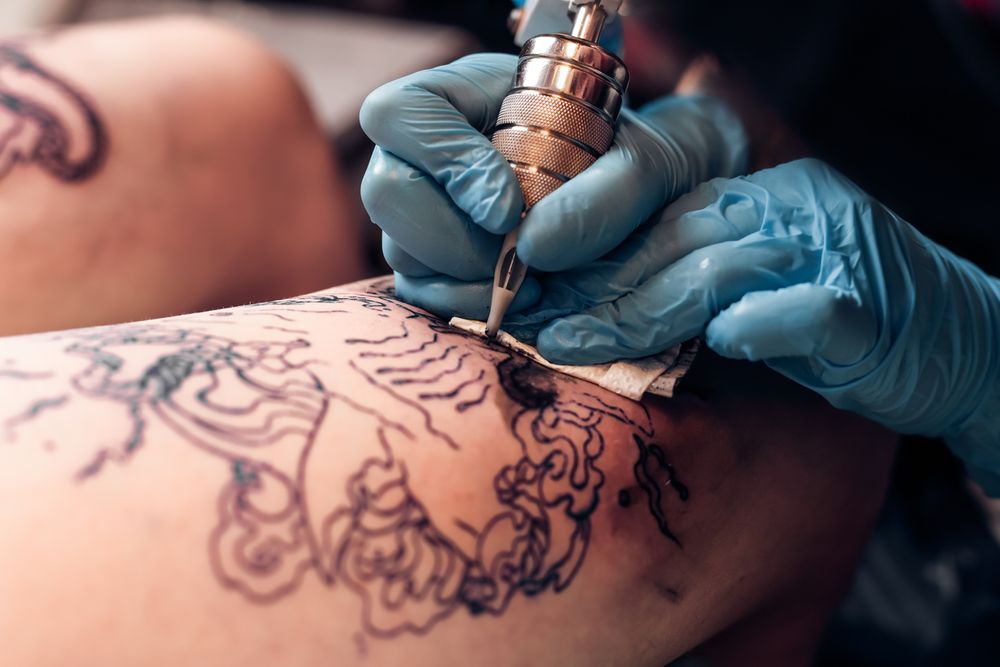
A few common symptoms of tattoo infection include:
- Prolonged redness lasting more than a week after getting inked.
- Swollen or puffy skin or persistent itching and hives a few days after getting a tattoo. This symptom might indicate either an allergic reaction to the tattoo ink or an early sign of infection.
- Burning sensation in the tattoo area.
- Tenderness in the tattooed skin or worsening pain when touched lasting more than a week after getting the tattoo.
- Pus or oozing even after 2-3 days after getting inked.
- A foul odor coming from the tattooed skin is a good indication of infection. You should seek medical attention if such a symptom occurs.
- Fever and chills also indicate an infection. In this case, it’s essential to seek medical help right away.
- Scarring after your new ink starts scabbing is either because of an allergic reaction or a tattoo infection.
If any of these symptoms continue after a week or two after getting a tattoo, talk to a trusted tattoo artist about it or your dermatologist or a medical professional. They can give your proper information, advice, and treatment recommendations.
In many cases, tattoo infection is easily treated with antibiotics. However, if that doesn’t alleviate the rashes and swelling even after a week of treatment, you might have to consider tattoo removal.
Can You Get Another Tattoo While the First One Is Healing?
Technically, you can get multiple tattoos together or one after the other. However, the healing of both wounds can be a tricky endeavor.
Firstly, your body would already be fighting a lot to prevent infection as the first one heals. Adding what is, essentially, another wound can overwhelm your body, prolonging the time it takes for both tattoos to heal completely.
Not to mention the possible aftercare routine issues that come with taking care of two different tattoos.
Try spacing out getting inks for at least a month or two if you can. That should be enough time for the first one to heal, at least on the surface level.
Final Thoughts – How Long Does It Take for a Tattoo to Heal?
As they say, time will heal all wounds, and the same goes for tattoos. But, unfortunately, while the body has the capacity to heal, it doesn’t just happen overnight.
A tattoo will generally take 2-4 weeks to heal on the surface and 4-6 months to heal internally. During this time, it’s vital to closely follow aftercare guidance to avoid any complications and ensure that your new ink heals properly and as quickly as possible.
Once your tattoo is healed and you can wear it with pride, you’ll be glad to have taken the time to take extra care of it during the entire healing period.
Now that you know how long it takes for a tattoo to heal, it’s time to check out the best tattoo ideas to inspire your first or your next one.




